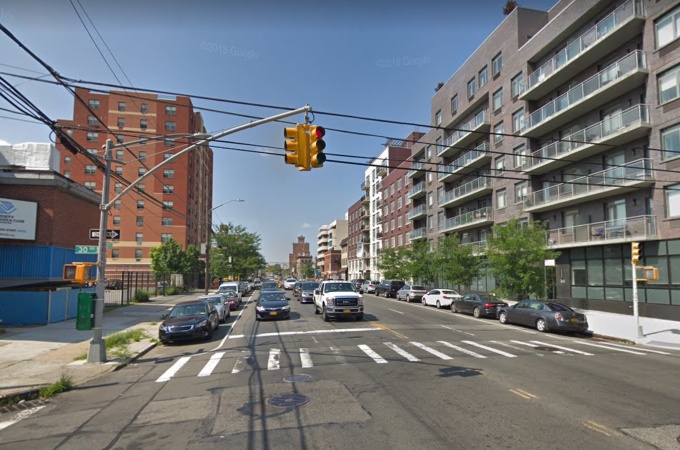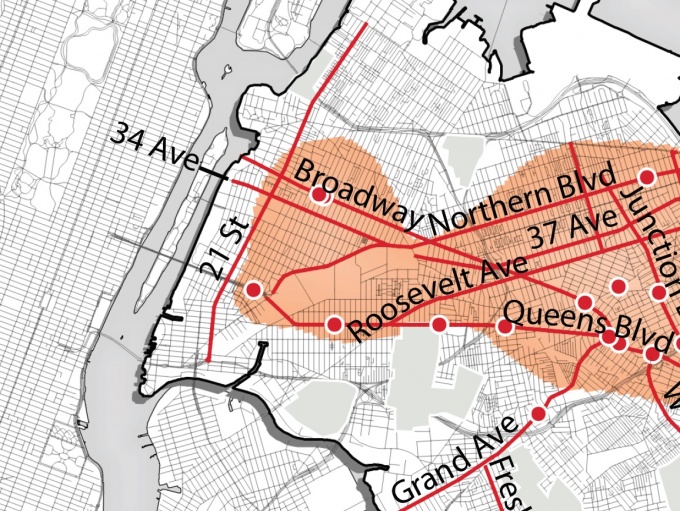
21st Street and 30th Road, where a 45-year-old man was killed in a hit-and-run in 2016. The DOT has listed nearly the entire length of the stretch as a priority corridor in its new vision zero plan. (Google Maps)
Feb. 20, 2019 By Nathaly Pesantez
A new Vision Zero plan released yesterday lists 21st Street, running between Astoria and Long Island City, among several priority corridors in the five boroughs that have proven dangerous and are now the focus of new safety initiatives by the city.
The Department of Transportation added the 3.6-mile length of 21st Street between 50th and 20th Avenues in its updated Borough Pedestrian Safety Action Plans, which outline priority corridors, intersections and areas that combined have made up a significant portion of all pedestrian fatalities and injuries over the years.
“In these updated plans, we have used the freshest data to identify new crash-prone corridors and intersections most in need of our full menu of safety interventions,” said Polly Trottenberg, DOT Commissioner.
The 21st Street length is part of 424 miles of priority corridors in the five boroughs that, despite making up 7 percent of city streets, are responsible for nearly half of total pedestrian fatalities citywide. The Astoria and Long Island City stretch is also among 114 miles of priority corridors in Queens that saw roughly half of all pedestrian fatalities in the borough.
The DOT said 21st Street, along the near 50-block length, saw 4.2 pedestrians killed or severely injured per mile from 2012 to 2016, a whopping 50 percent jump from the 2.8 KSI figure recorded between 2009 and 2013 on the street.

The 21st Street priority corridor, among other priority intersections and areas selected by the DOT for safety interventions. (DOT)
The stretch saw two pedestrians die from 2012 to 2016, while 14 pedestrians were severely injured during the time frame.
The street is part of five new corridors in Queens the DOT is targeting for immediate and long-term safety interventions. The new corridors are also among 30 streets and avenues in Queens the agency is still keeping its sights on after listing them in its Vision Zero roll out four years ago, like Queens Boulevard, Main Street, Roosevelt Avenue and Northern Boulevard.
Citywide, 293 priority intersections have been selected (68 of which are in Queens) and 60 square miles of priority areas.
To up safety at the priority corridors, the DOT will be adding Leading Pedestrian Interval Signals, which show walk signs for pedestrians before showing a green light to vehicles, “at every feasible intersection” by the end of 2019.
Signal timing will also be modified to reduce speeding “on all feasible new priority corridors” by the end of the year.
The agency will also focus on long-term efforts like tracking vision zero violations at the priority locations to better pinpoint where and how problems arise, enhancing NYPD and DOT presence at corridors, and launching other outreach and safety awareness programs.
The action plans, save for the LPI installation and signal timing modifications, will be rolled out over the next three years.
While 21st Street is now a priority corridor, the stretch has been a problem area for years, with many calls made to make the street safer.
The DOT implemented some increased safety measures on parts of the street in 2015 given the staggering number of pedestrian injuries and deaths reported in prior years, but the injuries and deaths have notably continued on the stretch.
In 2016, a traffic light was installed at the corner of 21st Street and 30th Road, where a 45-year-old pedestrian was killed in a hit-and-run months before. The agency, however, had rejected calls for a stoplight at the location just a year prior, saying it didn’t meet the criteria at the time.
And while outside of the crash data the DOT used in its priority corridor selection, a pedestrian died in 2017 days after she was struck by a car while crossing the street at 40th Avenue.
4 Comments

I welcome anything that reduces the amount of reckless behavior from drivers in western Queens. It needs to stop. They need to get tickets and get their driving privileges revoked. Zero tolerance policy. STOP BLAMING IT ON PEDESTRIANS. Pedestrians aren’t the ones driving around in a 4,000 pound machine! These are things I see, literally, EVERY DAY:
– blowing red lights
– making U-turns in the middle of intersections
– honking at pedestrians as they try to cross the street
– intimidating pedestrians as they cross by speeding up to them and stopping inches from their bodies at a crosswalk
– endless honking of horns while we (or our kids) are trying to sleep
– juiced-up engines designed to make loud noise and attract attention
– speeding
– rapidly backing up down a one-way street to steal a parking spot
– talking on cell phones
– honking at cyclists to go faster
– cutting cyclists off at corners
It needs to stop.
Go back even further, and there are so many deaths on 21st Street. I remember a child killed years ago near where the post office used to be. So sad. What is shocking is that the city didn’t do something about this street earlier.
Drivers of motor vehicle are not entirely at fault, maybe legally drivers are at fault due to laws but not morally. I am consistently seeing pedestrians doing stupid things.
People walk out from between parked cars, in the middle of the street and not at the intersection, dressed entirely in black, and always with their faces buried in their
electronic devices and at night. Its as if some powerful force is making people stupid
and that powerful force is the addiction to electronics. The force is so powerful that people are just not paying attention to where they are and what they are doing so
they do not pay attention when they cross a street nor do they abide by laws that tell them to cross at the intersections and with the light in their favor.
May I ask what ever happen to common sense?
Add to this problem drivers now have to constantly watch for potholes, the streets in Queens are in terrible shape, bicyclists not
obeying the law, themselves distracted by the use of electronic devices.
People flinging open car doors without first checking for oncoming traffic,
double parked cars, etc…. and the overpopulation of people and vehicles.
50 years ago growing up in Astoria not many people had cars. In fact you were lucky if your family did. If your family did have a car the car belonged to your Dad for they needed a car to get to work. Most Mothers did not drive. I remember when you actually could find a place to park your car and without having to ride around and around the neighborhood over and over again. There are just way too many cars now.
“50 years ago growing up in Astoria not many people had cars. In fact you were lucky if your family did. If your family did have a car the car belonged to your Dad for they needed a car to get to work. Most Mothers did not drive. I remember when you actually could find a place to park your car and without having to ride around and around the neighborhood over and over again. There are just way too many cars now.”
Cannot agree more with this statement. People say all the time that they must have a car when years ago people got around just fine in the area without them.